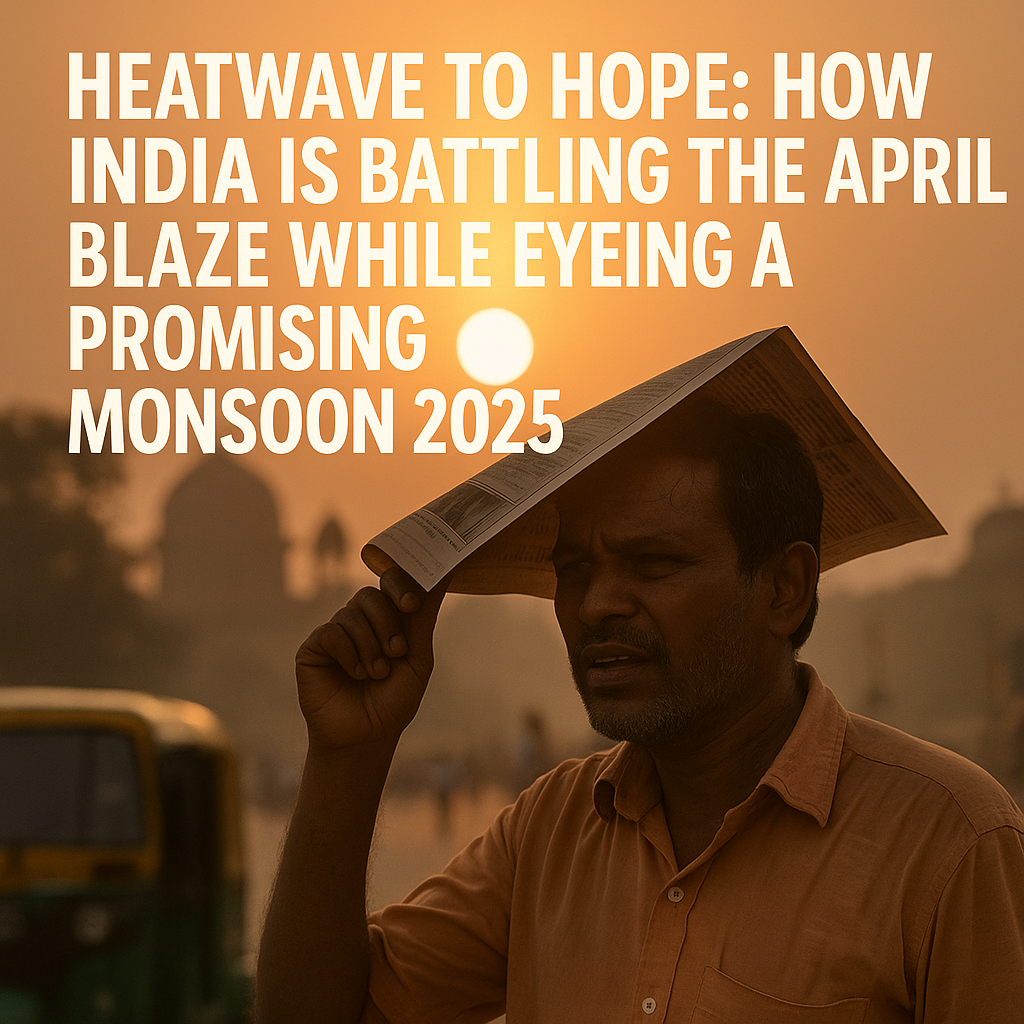Heatwave to Hope: How India Is Battling the April Blaze While Eyeing a Promising Monsoon 2025
Heatwave to Hope
As April unfolds, India finds itself standing between two extreme weather events—scorching heatwaves and the hopeful arrival of an abundant monsoon. This dynamic climate shift is not only shaping daily lives but also playing a crucial role in agriculture, economy, and policy-making. Let’s take a deep dive into India’s current weather situation and what lies ahead in 2025.
Heatwaves Hit Hard: April Turns Sizzling
Heatwave to Hope, This April, India is witnessing one of its most intense hot spells in recent memory. The India Meteorological Department (IMD) has issued alerts for prolonged periods of extreme heat, especially in the central, western, and peninsular regions.
Typically, states like Maharashtra, Gujarat, Rajasthan, and parts of Madhya Pradesh see 4–8 heatwave days. However, 2025 is rewriting the norm, with forecasts suggesting up to 20 days of extreme temperatures in certain regions.
Experts say this spike is the outcome of both climate change and rapid urbanization. Cities with limited green cover and high concrete density are especially vulnerable, turning into “heat islands” that trap and amplify temperatures.
Monsoon 2025: High Hopes for Rain Revival
Heatwave to Hope, While the sun blazes in the sky, the IMD has shared a silver lining. The upcoming monsoon season (June–September) is expected to bring above-average rainfall, with estimates at 105% of the long-period average (LPA).
This marks the second year in a row with a favorable monsoon outlook. Private forecaster Sky met Weather also predicts a normal monsoon, pegged at 103% of LPA. Regions like Maharashtra, Madhya Pradesh, and parts of the Western Ghats could receive surplus rainfall, providing much-needed relief to the parched land.
The absence of the El Niño phenomenon—which typically disrupts Indian rainfall—is another positive signal. Without El Niño’s interference, the rainfall distribution is expected to be more even and beneficial for crop cycles.
The Economic Angle: From Farmlands to Food Prices
Heatwave to Hope, India’s agricultural sector, which depends heavily on the monsoon, stands to gain immensely from this forecast. Over 50% of India’s arable land lacks irrigation, making it entirely reliant on seasonal rains.
A good monsoon could:
- Boost crop yields, especially rice, pulses, sugarcane, and oilseeds.
- Lower food inflation, which currently sits at a 5-year low.
- Support exports of rice, onions, and sugar, which had faced restrictions in 2024.
- Encourage RBI to consider interest rate cuts, fostering economic activity.
In short, the monsoon is not just a weather event—it’s a macro-economic driver for the entire nation.
Smart Skies: India Turns to AI and Tech for Weather Predictions
Heatwave to Hope, India is going beyond traditional forecasting methods by embracing technology in a big way.
The launch of “Mission Mausam”, spearheaded by Prime Minister Narendra Modi, aims to transform India into a weather-ready and climate-resilient nation. This program is introducing:
- High-resolution radars
- Advanced weather satellites
- Real-time data analytics
- Community-level weather alerts
At the same time, the IMD is integrating Artificial Intelligence (AI) and machine learning into its forecasting systems. These AI-powered models are delivering more accurate 1–3 day precipitation forecasts, reducing errors that once plagued short-term predictions.
Meanwhile, Google’s DeepMind team has developed GenCast, a powerful AI model capable of generating ensemble forecasts that can anticipate extreme weather events days in advance. These tools are expected to revolutionize how India prepares for and responds to climate risks.
Helping the Farmers: Digital Forecasts at Ground Level
Heatwave to Hope, One of the most promising developments is the expansion of Agro-Meteorological Advisory Services (AAS) under IMD. Through these services:
- Farmers receive district-wise forecasts via SMS or local Krishi Vigyan Kendras.
- Advisory bulletins guide them on sowing, irrigation, fertilizer use, and harvesting.
This localized, tech-driven model is helping millions of Indian farmers make better decisions, reduce losses, and improve yields—all powered by AI, big data, and weather modeling.
Climate Challenges Ahead: Preparing for Extremes
Heatwave to Hope, Even with a good monsoon forecast, India cannot ignore the larger trend of increasing climate variability. The record temperatures this year, shrinking glaciers, and shifting rainfall patterns indicate that climate resilience needs to be a priority.
Government and private agencies are being urged to:
- Increase tree plantation and green cover in urban areas.
- Promote water conservation, including rainwater harvesting and efficient irrigation.
- Expand public awareness campaigns on heat safety and climate adaptation.
Final Thoughts: Between the Heat and the Hope
Heatwave to Hope, April 2025 paints a vivid picture of the climate crossroads India stands at. While the heatwaves have sparked concern and urgency, the promising monsoon forecast brings relief and opportunity.
As the country embraces next-gen weather forecasting, expands digital agri-support, and invests in sustainable infrastructure, India is not just reacting to climate—it’s preparing to lead the charge in resilience and adaptation.
This isn’t just a weather story—it’s a national strategy for survival and growth.

